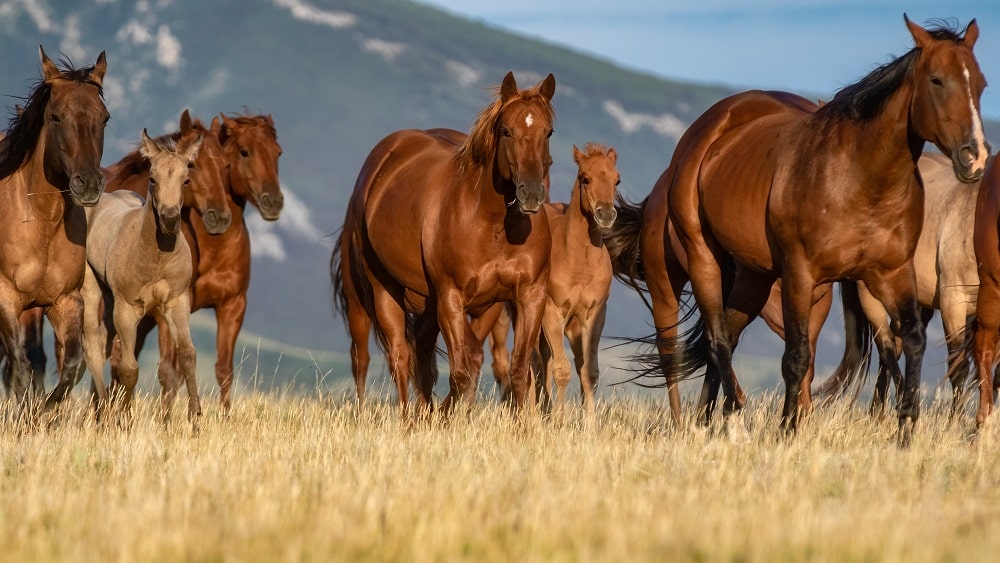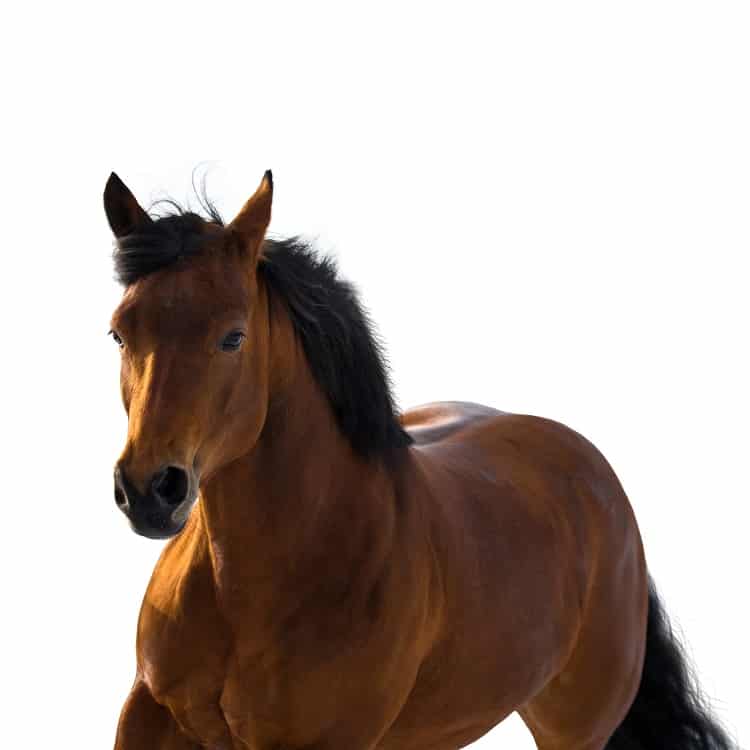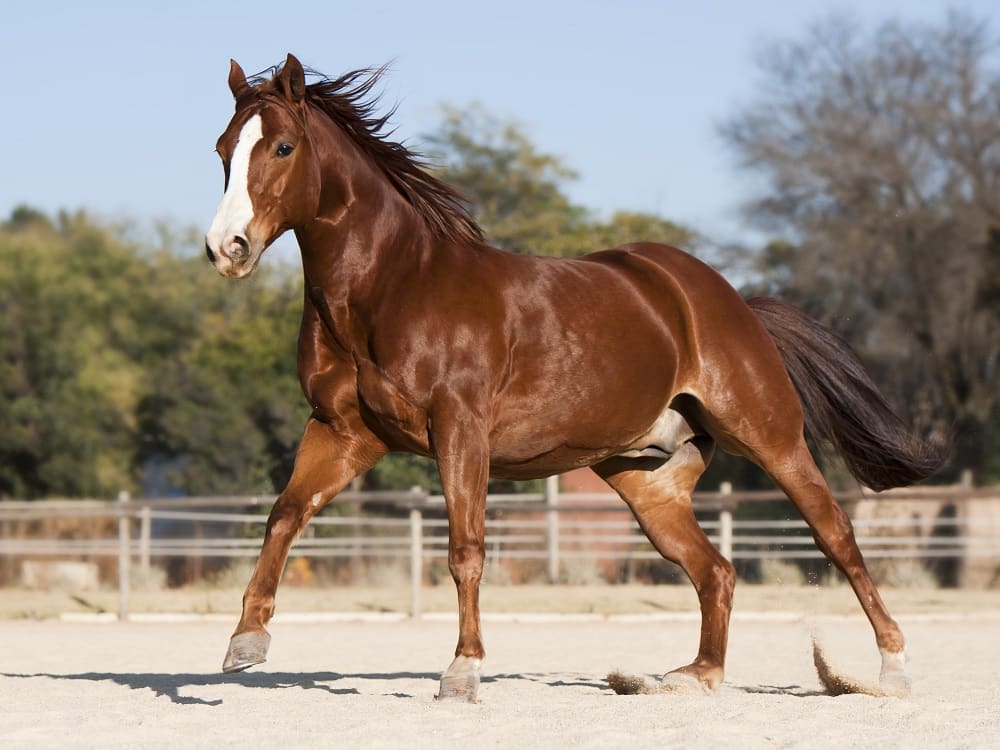
Vital Stats
| WEIGHT: | 430 – 545kg |
| HEIGHT: | 14 hands – 16 hands |
| LIFE EXPECTANCY: | 25 years |
| BEST FOR: | Ranch work, racing, shows, leisure riding and more |
| ORIGIN: | United States of America |
Order now for delivery on Tuesday 9th December
Quick, agile, gentle and loyal: the Quarter Horse, or American Quarter Horse, is one of the most popular horse breeds in the United States, with a variety of strings to its bow. The Quarter Horse has had many uses over the years: they have been used as race horses, work horses, in rodeos, on ranches, and plenty more!
With a friendly temperament and a highly trainable nature, the Quarter Horse is a good choice for riders of all levels, and is often seen across a range of settings. You may spot one American Quarter Horse carrying out police work, while another Quarter Horse may be competing in dressage, and another putting in the hours on an American ranch!
However, this striking horse is perhaps best known for its speed: the American Quarter Horse is incredibly fast, reaching speeds of up to 55mph, and Quarter horse races are a popular sport across the United States.


| WEIGHT: | 430 – 545kg |
| HEIGHT: | 14 hands – 16 hands |
| LIFE EXPECTANCY: | 25 years |
| BEST FOR: | Ranch work, racing, shows, leisure riding and more |
| ORIGIN: | United States of America |
The Quarter Horse originated in the 16th century, when Thoroughbred horses were bred with native horses on the eastern coast of the United States during the colonial era. The result was a fast, compact horse which was used as both a work and a racehorse; in fact, it was the growing popularity of flat racing and the speed of the Quarter horse over the quarter mile race distance which gave it its name.
During the 19th century, the Quarter Horse gained popularity with settlers heading west, who crossbred the colonial Quarter Horse with native breeds including the Mustang, to create an agile horse who had what became known as a ‘cow sense’: a talent for working with cattle.
Over the years, the Quarter Horse would maintain its popularity on American ranches, as well as becoming popular at rodeos and in weekend races. 1940 saw the creation of the American Quarter Horse Association, which is today the largest breed registry in the world.
Today, the breed continues to work on ranches across northern America, as well as competing in rodeos and racing. It is also used as a show horse, in trail riding, in dressage, as a family horse, and much more. Its popularity is shown both in its versatility and in its numbers: there are over three million American Quarter Horses registered around the world, and the American Quarter Horse Museum is dedicated to showcasing this equine breed.
Standing at between 14 – 16hh, the American Quarter Horse is stocky and muscular, with their weight ranging from 430 – 545kg. There are varying types of Quarter Horse: stock type Quarter Horses tend to be shorter and stockier, while hunter or racing type Quarter Horses are taller and leaner.
The American Quarter horse has a muscular appearance, and can be found in a wide variety of colours. The list of accepted colours is relatively long, and includes bay, black, brown, buckskin, palomino, duns and roans. However, it is the brownish red sorrel colour which is most commonly seen in the American Quarter Horse.
While spotted colours were once banned, today the American Quarter Horse Registry will accept horses of this pattern, and indeed of all colours, if both parents are also registered.
There are a number of types of Quarter Horse: the stock Quarter Horse, the racing and hunter type Quarter Horse, and the halter Quarter Horse. Each is suited to a different purpose and has a slightly different appearance. Stock Quarter Horses tend to be smaller and stockier; racing and hunter Quarter Horses are usually lean with longer legs; while halter Quarter Horses are large and significantly more muscular.
Quarter Horses are happy to eat a regular equine diet of quality hay, grain, vegetables and fruits, with fresh grass, hay and grains forming the bulk of their diet.
Treats like carrots and apples will always be appreciated by the American Quarter Horse, and supplements can also be given. The American Quarter Horse is generally considered to be an easy keeper, and should be fed around 1.5 – 2% of their body weight daily.
One of the most unique characteristics of the Quarter Horse is its sheer speed: this agile and fast horse can reach speeds of up to 55mph over short distance sprints!
They also display a knack for working with cattle, which has earned them a reputation as having an innate ‘cow sense’.
The Quarter Horse is known for its calm, docile, intelligent and highly trainable nature, making them a great choice for riders of all levels including beginners; and as a family horse. They are hard working and eager to please, which has contributed to their success as a work horse throughout the years.
Quarter horses are susceptible to a range of genetic conditions, including:
Quarter Horses will benefit from a regular grooming regime to keep their coat and skin in top condition. Daily brushing before and after a ride will help them to feel comfortable, while their manes and tails should be brushed regularly to avoid tangles. Pulling the mane is a good way to manage it, while the grooming regime for a Quarter Horse should also include currying, brushing and towelling.
The typical lifespan of a healthy Quarter Horse is 25 years.
The reasons to choose a Quarter Horse are plentiful: this versatile equine is a great choice for a wide variety of purposes! When it comes to riding, the Quarter Horse is trainable, gentle and intelligent with a steady nature, making it a good choice for everyone from beginners to more experienced riders.
They are also popular as ranch horses and in rodeo events, as well as for western and trail riding horses, dressage, and even as mounted police horses.
Quarter Horse racing remains a popular sport, and American Quarter Horses are often chosen as race horses, excelling over shorter distances. Quarter Horse jumping is another popular use for the Quarter Horse.
